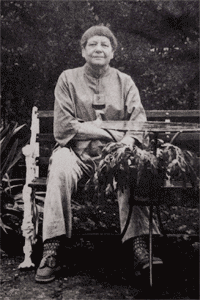Nan Youngman facts for kids
Nancy Mayhew Youngman (June 28, 1906 – April 17, 1995) was an English painter and a very important person in art education. She is mostly known for her paintings. But from before World War II until the mid-1960s, she also greatly influenced how art was taught. She was a teacher, a writer, and a very good organizer of art shows.
Contents
Early Life and Art Training
Nan Youngman was born in Maidstone, England, in 1906. Her father, John Henry Youngman, was a business partner in a company that sold corn. Nan went to Wycombe Abbey School. After that, she studied art at the Slade School of Art from 1924 to 1927. There, famous artists like Philip Wilson Steer and Henry Tonks taught her.
After leaving Slade, Nan Youngman decided to become an art teacher. She studied at the London Day Training College. A teacher named Marion Richardson helped her learn about children's art. Marion also introduced her to Roger Fry, a well-known art critic.
From 1929 to 1944, Nan spent her time painting and teaching. She gave talks for the London County Council. She also taught art classes to schoolteachers and worked part-time. Organizing art shows became a key way for her to help children learn more about art.
Career in Art and Education
During the 1930s, Nan Youngman showed her paintings at the Wertheim Gallery and with a group called The London Group.
In 1936, her friend, the artist Felicia Browne, died during the Spanish Civil War. This event changed Nan Youngman's views on the world. She joined a group called the Artists' International Association (AIA). This group believed in fairness for everyone. Nan organized a special art show to remember Felicia Browne. The AIA group shows became a main place for Nan to display her paintings. Even though she was part of a political group, her own art did not usually show political messages. In 1939, Nan Youngman famously invited a workman from the street into the AIA's "Art for All" exhibition.
In 1944, Nan Youngman became an art advisor for Cambridgeshire. She worked under Henry Morris, who was a leader in education.
Pictures for Schools Exhibitions
In 1945, Nan Youngman became the chairman of the Society for Education through Art (SEA). She wrote about her ideas in art journals. Through the SEA, she started a special series of art shows called "Pictures for Schools." These shows displayed modern art that schools could buy. The first show was held in 1947 at the Victoria and Albert Museum. These shows continued every year until 1969, often at the Whitechapel Gallery.
In the 1950s, Nan Youngman traveled to places like the West Indies, Malta, and Ghana. She gave talks about art education for the British Council. During this time, she also started spending more time on her own painting.
While setting up "Pictures for Schools" shows in Wales, Nan discovered the beautiful landscapes of the Rhondda Valley. Many of her later paintings were inspired by these views. In 1965, she moved to a house called The Hawks, near Waterbeach in The Fens. Her paintings of landscapes became even more detailed and beautiful after this move.
Nan Youngman was given a special award, the Officer of the British Empire (OBE), in 1987 for her important work.
Personal Life
Nan Youngman met the sculptor Betty Rea through their work with the Artists International Association and the SEA. They shared a home and raised a family together. In 1939, during World War II, they moved with Highbury Hill School to Huntingdon. They lived in a caravan on the grounds of Hinchingbrooke House. Later, they made a family home, first in Godmanchester and then in Papermills in Cambridge. They raised an extended family, including Betty Rea's two children and three other children they cared for temporarily.


